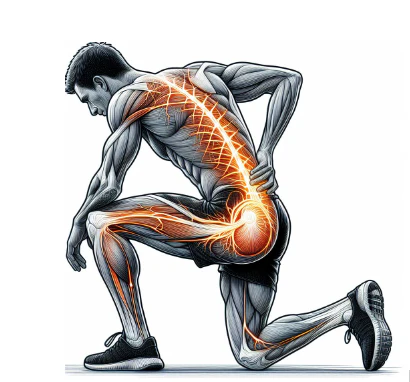When our ancestors ran, they were really good at it. They didn’t have a pair of sweet Nike kicks with a blow up tongue. They had a pair of wide flat shoes that were made of natural material, if any at all. This allowed their feet to work like… well feet. Imagine wearing these shoes. Basically a thin piece of leather with rope tied around your ankle to hold them on. Now picture yourself jumping up and landing on your heels, ouch! Now imagine yourself in those big squishy Nike’s doing the same thing… not so bad. In the Nikes you can get away with improper movement patterns because of the foam under your feet. Does this mean that Nike lied to you so they could make more money?!?!…. well… yeah. They want to sell a shoe that is more comfortable and stylish. I don’t believe board members are trying to do what’s right for your foot health.
When you jump up and land on your heels, biomechanically you’re transferring all that stress into your knees, then into your hips, then into your low back and so on. When you run with these shoes on you can land on that big squishy heel again and again and again (you get the point). This transfers all that ground reaction force into the skeleton and makes your running form extremely inefficient.
Proper biomechanics while running isn’t the same as walking. As you step forward while running you should be landing on your forefoot. This means around the ball of your foot to midfoot. As you shift weight onto that leg the heel is lowered to the ground using muscle and fascia. as the heel touches the ground softly it’s time to push off again. This short time between when you land and when you push off is incredibly important for efficiency. This is because the fascia that surrounds all of your muscles is highly elastic and acts like a rubber band. When it is quickly stretched it will quickly contract back. This mechanism is what makes forefoot running more efficient, and dare I say… easier! (can I get a hallelujah?)
There’s also another mechanism at work here, levers. The achilles is a 2nd class lever. Think like a wheel barrow. The achilles is pulling the heel up, the ball of the foot is the fulcrum, and the middle of the foot is where your weight is. This is the only 2nd class lever in the body, as most of them are 3rd class which are good at range of motion but poor at developing a mechanical advantage.
Now if you’re a heel striker then it’s going to take some time to adapt to a new running style. As with any new workout plan take it slowly. You’re going to have to increase the cadence of steps per minute while developing the proper muscles to adhere to the change in demand. A good drill to do is mimicking running with high knees. High knee running is an exaggerated running form but proper landing patterns as your feet touch down. Over time, the new running pattern will become ingrained into you. You’ll be able to run and actually enjoy it!






